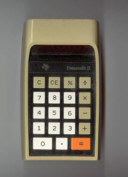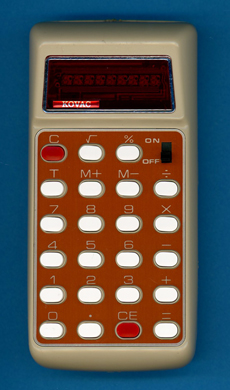
DATAMATH CALCULATOR MUSEUM
 |
DATAMATH CALCULATOR MUSEUM |
Kovac LE-808MR (Beetle)
| Date of introduction: | September 1974 | Display technology: | LED-stick |
| New price: | Display size: | 8 + Sign | |
| Size: | 4.6" x 2.4" x
1.25" 118 x 61 x 32 mm3 |
||
| Weight: | 3.3 ounces, 94 grams | Serial No: | 097859 |
| Batteries: | 9V | Date of manufacture: | mth 05 year 1975 |
| AC-Adapter: | Origin of manufacture: | USA | |
| Precision: | 8 | Integrated circuits: | TMS0611, SN75491, SN75492 |
| Logic: | Chain | Displays: | Bowmar Optostic R7H-122-9 |
| Memories: | 1 | ||
| Program steps: | Courtesy of: | Joerg Woerner |

![]()
 Kovac Corporation of Osaka, Japan, started already in 1972 with the Model K80 manufacturing of battery-operated electronic calculators. Most of Kovac's later products were sold not only under the Kovac brand, but made their way as OEM products into the distribution channels of
Craig Electronics, Homeland, Prinztronic, Rambler, Unitrans, Ventron and others. Most of Kovac's
calculators are based on Texas Instruments' early single-chip calculator circuits,
the earliest designs used the TMS0105
chip. The Beetle series with their unique design was introduced in November 1973 and came
in two sizes, small with five rows of keys and medium with six rows of keys. The
smaller four- or five-function calculators were designed around chips from the
TMS0800 Product Family while the more
enhanced products made use of the TMS0600
Product Family. As of today we know five members of Kovac's Beetle series:
Kovac Corporation of Osaka, Japan, started already in 1972 with the Model K80 manufacturing of battery-operated electronic calculators. Most of Kovac's later products were sold not only under the Kovac brand, but made their way as OEM products into the distribution channels of
Craig Electronics, Homeland, Prinztronic, Rambler, Unitrans, Ventron and others. Most of Kovac's
calculators are based on Texas Instruments' early single-chip calculator circuits,
the earliest designs used the TMS0105
chip. The Beetle series with their unique design was introduced in November 1973 and came
in two sizes, small with five rows of keys and medium with six rows of keys. The
smaller four- or five-function calculators were designed around chips from the
TMS0800 Product Family while the more
enhanced products made use of the TMS0600
Product Family. As of today we know five members of Kovac's Beetle series:
| Calculator | Alternative Designation |
# of Keys / Switches |
Keys | Switches | Calculator Chip |
| LE-808 | 19 / 1 | [0-9][.][+][−][×][÷][=] [C][CE][D] |
[OFF-ON] | TMS0801 | |
| LE-808P | LE-8-7 Mini 8 |
19 / 1 | [0-9][.][+][−][×][÷][=] [C][D][%] |
[OFF-ON] | TMS0803 |
| LE-808R | LE-8-7R Mini 8R |
22 / 1 | [0-9][.][+][−][×][÷][=] [C][CE][D][%][√x][RE] |
[OFF-ON] | TMS0807 |
| LE-808M | LE-8-7M Mini 8M |
22 / 2 | [0-9][.][+][−][×][÷][=] [C][%][1/x][x2][CM][MR] |
[OFF-ON] [▲ M] |
TMS0603 |
| LE-808MR | LE-8-7MII Mini 8MR |
23 / 1 | [0-9][.][+][−][×][÷][=] [C][%][1/x][x2][CM][MR] |
[OFF-ON] | TMS0611 |


 Dismantling
the featured Kovac LE-808MR calculator manufactured in May 1975 in Japan reveals
- a beautiful mess with many colorful wires. Three different printed circuit
boards (PCBs) are stuffed into the rather small package of the calculator, with
its Bowmar Optostic display connected with 17 wires to the Main-PCB and the
Keyboard-PCB using a connector for 11 of its 14 signals to the Main-PCB and 3
discrete wires for the remaining signals. Some additional wires connect the
battery terminals and charging port to the electronics. Definitely not designed
for easy servicing but having a Return-of-Invest calculation in mind. In Product
Development Projects like this electronic calculator, there are four numbers
from importance:
Dismantling
the featured Kovac LE-808MR calculator manufactured in May 1975 in Japan reveals
- a beautiful mess with many colorful wires. Three different printed circuit
boards (PCBs) are stuffed into the rather small package of the calculator, with
its Bowmar Optostic display connected with 17 wires to the Main-PCB and the
Keyboard-PCB using a connector for 11 of its 14 signals to the Main-PCB and 3
discrete wires for the remaining signals. Some additional wires connect the
battery terminals and charging port to the electronics. Definitely not designed
for easy servicing but having a Return-of-Invest calculation in mind. In Product
Development Projects like this electronic calculator, there are four numbers
from importance:
| • Number of units manufactured • Sales price per unit • Manufacturing costs per unit • Development costs of the product |
With the first two bullet points defined by the Product Manager, the Development Engineers needs to balance manufacturing costs vs. development costs - with labor costs in 1974 still very low in Japan, it is obvious that needs to balance manufacturing costs vs. development costs - with labor costs in 1974 still very low in Japan, it is obvious that the Project Manager decided to keep development costs of the electronics rather low.
![]() Calculating Unit:
The TMS0611 located in the featured Kovac LE-808MR calculator is a member of the TMS0600 Product Family and tracing back to
the TMS1802NC, the first available standard calculator building block on a chip,
later renamed into TMS0102. The TMS0600
increased the size of the Instruction ROM (Read-Only Memory), kept the Data
Memory and added integrated
segment drivers for the LED display.
Calculating Unit:
The TMS0611 located in the featured Kovac LE-808MR calculator is a member of the TMS0600 Product Family and tracing back to
the TMS1802NC, the first available standard calculator building block on a chip,
later renamed into TMS0102. The TMS0600
increased the size of the Instruction ROM (Read-Only Memory), kept the Data
Memory and added integrated
segment drivers for the LED display.
Display: This
featured Kovac LE-808MR calculator manufactured in May 1975 makes use of a Bowmar Optostic R7H-122-9
Nine-Digit display module using Chip-on-Board (COB) technology with each
character formed by bonding seven individual Segment chips and one Comma chip
bonded directly to a PCB and protected with a red plastic lens. The display
module is connected with a 17 colorful wires to the Main-PCB. The clear
separation of the display module from the Main-PCB allowed on the other hand the
combination of a completely different Display-PCB with the same Main-PCB - enter Craig
Model 4518.
![]() Display Driver: The PCB of the
Kovac LE-808MR makes use of an unusual combination of one
SN75491 Segment
Driver and one SN75492 Digit Driver - inspecting the layout of the Main-PCB of
the Craig Model 4518 used for the
Characterization of the TMS0611 the reveals that the SN75491 Segment Driver was repurposed to act as a Digit Driver for
three digits of the LED display while the SN75492 Digit Driver serves the other
six digits. The calculator design utilizes the integrated Segment Drivers
of the TMS0611 chip.
Display Driver: The PCB of the
Kovac LE-808MR makes use of an unusual combination of one
SN75491 Segment
Driver and one SN75492 Digit Driver - inspecting the layout of the Main-PCB of
the Craig Model 4518 used for the
Characterization of the TMS0611 the reveals that the SN75491 Segment Driver was repurposed to act as a Digit Driver for
three digits of the LED display while the SN75492 Digit Driver serves the other
six digits. The calculator design utilizes the integrated Segment Drivers
of the TMS0611 chip.
Clock: The Kovac LE-808MR uses an astable multivibrator composed of
two 2SC711 NPN bipolar junction transistors (BJTs), two 100 pF ceramic
capacitors and four resistors (47 kOhm and 1.5 kOhm) for the clock generation of
the TMS0611 single-chip calculator circuit. We calculated with this values a
clock frequency of around 150 kHz.
Power Supply: The Kovac LE-808MR is powered by a disposable 9 Volt
battery and can be operated with an external, DC adapter, too. The Main-PCB of the calculator hosts a discrete power converter to generate
the VDD and VGG supply voltages for the TMS0611 chip.
Keyboard: The Kovac LE-808MR calculator makes use of a complex keyboard assembled with individual long-stroke push-button switches pushing conductive elements against small contacts etched into the Keyboard-PCB. The switches are arranged in an 11*3 matrix and require consequently 14 connections to the TMS0611 single-chip calculator circuit. Eleven of the 14 signals are brought to 12 connector pads on the bottom of the Keyboard-PCB while the remaining 3 signals are hand-soldered onto small pads on the top of the PCB. The 12 connector pads are most likely a relict from the TMS0800 chips using a 9*3 matrix for the keyboard.
If you have additions to the above article please email: joerg@datamath.org.
© Joerg Woerner, December 25, 2024. No reprints without written permission.